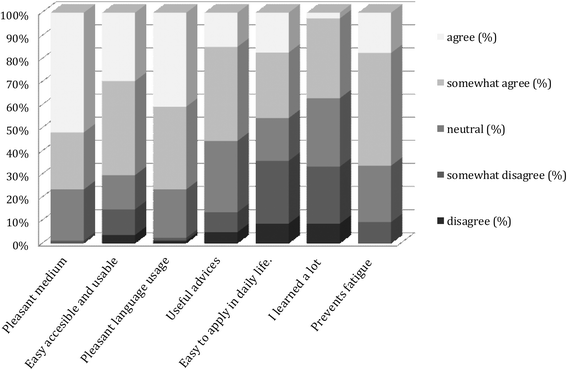Process evaluation of a tailored mobile health intervention aiming to reduce fatigue in airline pilots
- PMID: 27565140
- PMCID: PMC5002199
- DOI: 10.1186/s12889-016-3572-1
Process evaluation of a tailored mobile health intervention aiming to reduce fatigue in airline pilots
Abstract
Background: MORE Energy is a mobile health intervention which aims to reduce fatigue and improve health in airline pilots. The primary objective of this process evaluation was to assess the reach, dose delivered, compliance, fidelity, barriers and facilitators, and satisfaction of the intervention. The second objective was to investigate the associations of adherence to the intervention with compliance and with participant satisfaction. Thirdly, we investigated differences between the subgroups within the target population.
Methods: The intervention consisted of a smartphone application, supported by a website. It provided advice on optimal light exposure, sleep, nutrition, and physical activity, tailored to flight and personal characteristics. The reach of the intervention was determined by comparing the intervention group participants and the airline pilots who did not participate. The dose delivered was defined as the total number of participants that was sent an instruction email. Objective compliance was measured through the Control Management System of the application. To determine the fidelity, an extensive log was kept throughout the intervention period. Subjective compliance, satisfaction, barriers, facilitators, and adherence were assessed using online questionnaires. Associations between the extent to which the participants applied the advice in daily life (adherence), compliance, and satisfaction were analysed as well. Finally, outcomes of participants of different age groups and haul types were compared.
Results: A total of 2222 pilots were made aware of the study. From this group, 502 pilots met the inclusion criteria and did agree to participate. The reach of the study proved to be 22 % and the dose delivered was 99 %. The included pilots were randomized into the intervention group (n = 251) or the control group (n = 251). Of the intervention group participants, 81 % consulted any advice, while 17 % did this during four weeks or more. Fidelity was 67 %. The participants rated the intervention with a 6.4 (SD 1.6). Adherence was not associated with compliance, but was associated with satisfaction (p ≤ 0.001). Pilots of 35 to 45 year old were significantly more interested in advice regarding physical activity than their colleagues, and short-haul pilots were more interested in advice regarding nutrition compared to long-haul pilots.
Conclusions: The MORE Energy intervention was well received, resulting in an adequate reach and a high dose delivered. The compliance and satisfaction scores indicate that engagement and functionality should be enhanced, and the content and applicability of the advices should be improved to appeal all subgroups of the target population.
Trial registration: Nederlands Trial Register NTR2722 . Registered 27 January 2011.
Keywords: Implementation; Mobile health; Primary prevention; Process evaluation; Telemedicine; Work schedule tolerance.
Figures
Similar articles
-
Evaluation of an mHealth intervention aiming to improve health-related behavior and sleep and reduce fatigue among airline pilots.Scand J Work Environ Health. 2014 Nov;40(6):557-68. doi: 10.5271/sjweh.3447. Epub 2014 Aug 12. Scand J Work Environ Health. 2014. PMID: 25121620 Clinical Trial.
-
Development and evaluation of an intervention aiming to reduce fatigue in airline pilots: design of a randomised controlled trial.BMC Public Health. 2013 Aug 26;13:776. doi: 10.1186/1471-2458-13-776. BMC Public Health. 2013. PMID: 23971514 Free PMC article. Clinical Trial.
-
Impact of layover length on sleep, subjective fatigue levels, and sustained attention of long-haul airline pilots.Chronobiol Int. 2012 Jun;29(5):580-6. doi: 10.3109/07420528.2012.675222. Chronobiol Int. 2012. PMID: 22621354
-
Healthy Nutrition, Physical Activity, and Sleep Hygiene to Promote Cardiometabolic Health of Airline Pilots: A Narrative Review.J Lifestyle Med. 2023 Feb 28;13(1):1-15. doi: 10.15280/jlm.2023.13.1.1. J Lifestyle Med. 2023. PMID: 37250274 Free PMC article. Review.
-
Heart Messages: a tailored message intervention for improving heart failure outcomes.J Cardiovasc Nurs. 2000 Jul;14(4):94-105. doi: 10.1097/00005082-200007000-00007. J Cardiovasc Nurs. 2000. PMID: 10902106 Review.
Cited by
-
Advantages and disadvantages of mobile applications for workplace health promotion: A scoping review.PLoS One. 2024 Jan 2;19(1):e0296212. doi: 10.1371/journal.pone.0296212. eCollection 2024. PLoS One. 2024. PMID: 38165989 Free PMC article.
-
The role of medical data in efficient patient care delivery: a review.Risk Manag Healthc Policy. 2019 Apr 24;12:67-73. doi: 10.2147/RMHP.S179259. eCollection 2019. Risk Manag Healthc Policy. 2019. PMID: 31114410 Free PMC article. Review.
-
Cognitive Testing in People at Increased Risk of Dementia Using a Smartphone App: The iVitality Proof-of-Principle Study.JMIR Mhealth Uhealth. 2017 May 25;5(5):e68. doi: 10.2196/mhealth.6939. JMIR Mhealth Uhealth. 2017. PMID: 28546139 Free PMC article.
-
Perceptions and experiences of outdoor occupational workers using digital devices for geospatial biometeorological monitoring.Int J Biometeorol. 2020 Mar;64(3):471-483. doi: 10.1007/s00484-019-01833-8. Epub 2019 Dec 6. Int J Biometeorol. 2020. PMID: 31811392
-
Effectiveness of holistic mobile health interventions on diet, and physical, and mental health outcomes: a systematic review and meta-analysis.EClinicalMedicine. 2023 Nov 18;66:102309. doi: 10.1016/j.eclinm.2023.102309. eCollection 2023 Dec. EClinicalMedicine. 2023. PMID: 38053536 Free PMC article.
References
-
- Hauck EL, Avers KB, Banks JO, Blackwell LV. Evaluation of a Fatigue Countermeasures Training Program for Flight Attendants. Oklahoma City: Civil Aerospace Medical Institute, Federal Aviation Administration; 2011.
-
- Cabon P, Mollard R, Coblentz A, Fouillot JP, Speyer JJ. Recommendations for alertness and sleep management of aircrews operating longhaul flights. Med Aeronaut Spat. 1995;34(134):119–128.
Publication types
MeSH terms
Associated data
LinkOut - more resources
Full Text Sources
Other Literature Sources
Medical
Miscellaneous


